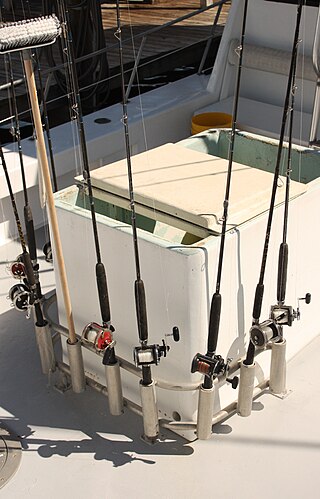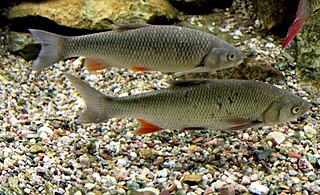
Fishing is the activity of trying to catch fish. Fish are often caught as wildlife from the natural environment, but may also be caught from stocked bodies of water such as ponds, canals, park wetlands and reservoirs. Fishing techniques include hand-gathering, spearing, netting, angling, shooting and trapping, as well as more destructive and often illegal techniques such as electrocution, blasting and poisoning.

Trolling is a method of fishing where one or more fishing lines, baited with lures or bait fish, are drawn through the water at a consistent, low speed. This may be behind a moving boat, or by slowly winding the line in when fishing from a static position, or even sweeping the line from side-to-side, e.g. when fishing from a jetty. Trolling is used to catch pelagic fish such as salmon, mackerel and kingfish.

A fishing rod is a long, thin rod used by anglers to catch fish by manipulating a line ending in a hook. At its most basic form, a fishing rod is a straight rigid stick/pole with a line attached to one end ; however, modern rods are usually elastic and generally have the line stored in a reel mounted at the rod handle, which is hand-cranked and controls the line retrieval, as well as numerous line-restricting rings that distribute bending stress along the rod and help dampening down/prevent line whipping and entanglement. To better entice fish, baits or lures are dressed onto the one or more hooks attached to the line, and a bite indicator is used, some of which might be incorporated as part of the rod itself.

The common chub, also known as the European chub or simply chub, is a species of European freshwater ray-finned fish in the carp family Cyprinidae, that frequents both slow and moderate rivers, as well as canals, lakes and still waterbodies of various kinds.

Fly fishing is an angling technique that uses an ultra-lightweight lure called an artificial fly, which typically mimics small invertebrates such as flying and aquatic insects to attract and catch fish. Because the mass of the fly lure is insufficient to overcome air resistance, it cannot be launched far using conventional gears and techniques, so specialized tackles are used instead and the casting techniques are significantly different from other forms of angling. It is also very common for the angler to wear waders, carry a hand net, and stand in the water when fishing.

Angling is a fishing technique that uses a fish hook attached to a fishing line to tether individual fish in the mouth. The fishing line is usually manipulated via a fishing rod, although rodless techniques such as handlining also exist. Modern angling rods are usually fitted with a fishing reel that functions as a cranking device for storing, retrieving and releasing out the line, although Tenkara fishing and traditional cane pole fishing are two rod-angling methods that do not use any reel. The fish hook itself can be additionally weighted with a denser tackle called a sinker, and is typically dressed with an appetizing bait to attract and entice the fish into swallowing the hook, but sometimes an inedible fake/imitation bait with multiple attached hooks is used instead of a single hook with edible bait. Some type of bite indicator, such as a float, a bell or a quiver tip, is often used to relay underwater status of the hook to the surface and alert the angler of a fish's presence.

The tiger muskellunge, commonly called tiger muskie, is a carnivorous fish, and is the usually sterile, hybrid offspring of the true muskellunge and the northern pike. It lives in fresh water and its range extends to Canada, the Northeast, and the Midwest United States. It grows quickly; in one study, tiger muskie grew 1.5 times as fast as muskellunge. Like other hybrid species, tiger muskie are said to have "hybrid vigor," meaning they grow faster and stronger than the parent fish, and are also less susceptible to disease. Trophy specimens weigh about 14 kg (30 lb). Its main diet is fish and small birds. The tiger muskie and the muskie are called the fish of 10,000 casts due to the challenge involved in catching them.

A fishing lure is any one of a broad category of artificial angling baits that are inedible replicas designed to mimic prey animals that attract the attention of predatory fish, typically via appearances, flashy colors, bright reflections, movements, vibrations and/or loud noises which appeal to the fish's predation instinct and entice it into gulping the lure. Angling activities using lures are known as lure fishing.
Heddon is a brand of artificial fishing lures created by James Heddon, who is credited with the invention of the first artificial fishing lures made of wood in the late 1890s.
Rapala is a manufacturer of fishing lures and other fishing related products. It was founded in Finland in 1936 by Lauri Rapala, who is credited for creating the world's first floating minnow lure carved from cork with a shoemaker's knife, covered with chocolate candy bar wrappers and melted photography film negatives, for a protective outer coating. His first fishing lure was created and designed for the purpose of catching pike. The floating minnow lure later, once the Rapala company was created, went on to become the first Rapala lure.

The Muddler Minnow is a popular and versatile artificial fly of the streamer type used in fly fishing and fly tying.

A spinnerbait or spinner is any one of a family of hybrid fishing lures that combines the designs of a swimbait with one or more spoon lure blades. Spinnerbaits get the name from the action of the metallic blades, which passively revolve around the attachment point like a spinning propeller when the lure is in motion, creating varying degrees of vibration and flashing that mimic small fish or other preys of interest to large predatory fishes. The two most popular types of spinnerbaits are the in-line spinner and safety pin spinnerbait, though others such as the tail spinner also exist. Spinnerbaits are used principally for catching freshwater fishes such as perch, pike and bass.

Fishing tackle is the equipment used by anglers when fishing. Almost any equipment or gear used in fishing can be called fishing tackle, examples being hooks, lines, baits/lures, rods, reels, floats, sinkers/feeders, nets, spears, gaffs and traps, as well as wires, snaps, beads, spoons, blades, spinners, clevises and tools that make it easy to tie knots.

Plugs are a popular type of hard-bodied fishing lure, characterized by a specially designed foil at the front end known as the bill or lip. Plugs are widely known by a number of other names depending on the country and region, including crankbait, wobbler, minnow, shallow-diver and deep-diver. The term minnow is usually used for long, slender, lures that imitate baitfish, while the term plug is usually used for shorter, deeper-bodied lures which imitate deeper-bodied fish, frogs and other prey. Shallow-diver and deep-diver refer to the diving capabilities of the lure, which depends on the size and angle of the lip, and lure buoyancy.
Lauri Rapala (1905–1974) was a Finnish fisherman, inventor and the founder of Rapala-Normark Group, the world's largest fishing lure and tackle producer. He died in 1974 at the age of 69. During the course of his life, he married once and fathered seven children. He created one of the first artificial fishing lures in 1936, which later became known as the Original Floater, a lure for which he would be made somewhat noted.

Fishing techniques are methods for catching fish. The term may also be applied to methods for catching other aquatic animals such as molluscs and edible marine invertebrates.
Grander Musashi, also known as Super Fisher Grander Musashi and Musashi the Great, is a Japanese manga series created by Takashi Teshirogi that was adapted into two anime seasons. It is a fishing sport anime that teaches audiences fishing methods. The target of this anime is usually families and children; it teaches them to appreciate nature and not destroy it. The main theme is protecting Mother Earth from being destroyed by technology and the greed of humans. It has influenced many audiences to fish for sport, as well as giving a good message to preserve nature. Grander Musashi is supported by the Fishing Club in Japan, and in the ending credits it shows a gallery of the bass fish they captured.
Kite fishing is a fishing technique. It involves a kite from which a drop line hangs, attached to a lure or bait. The kite is flown over the surface of a body of water, and the bait floats near the waterline until taken by a fish. The kite then drops immediately, signaling to the fisherman that the bait has been taken, and the fish can then be hauled in. Kites can provide boatless fishermen access to waters that would otherwise be available only to boats. Similarly, for boat owners, kites provide a way to fish in areas where it is not safe to navigate - such as shallows or coral reef.
Ron Lindner, was a sportsman and fishing industry innovator who has invented, along with his younger brother Al Lindner, many fishing lures and rigs including the Lindy Rig which has been used by tens of millions of anglers to catch walleye since it first hit the market in 1968. Lindner estimates that more than 70 million Lindy Rigs - and, as he put it, "its many imitators" - have been sold. Lindner also co-owns the Baxter, MN based Lindner Media Productions, along with Al and sons James, Daniel and Bill, which specializes in producing educational fishing programs, DVDs, videos, national TV commercials, product sales videos, point of purchase videos as well as providing underwater photography to the sport fishing industry. Lindner Media Productions customers include such well known companies as Rapala, Berkley, Lund Boats, Shimano, Blue Fox, Storm, MinnKota, Mustad, Nature Vision, Lindy Tackle, Humminbird, Frabill, VMC, HT Enterprises, Mercury Outboard Motors, and Gander Mountain. Lindner has been inducted into three fishing hall of fames and the Lindy Rig was featured in the Minnesota State Historical Society's 2008 list of "Minnesota’s 150 — The people, places, and things that shape our state".
Al Lindner is a sportsman, television and radio personality, and fishing industry innovator who has invented, along with his older brother Ron Lindner, many fishing lures and rigs including the Lindy Rig which has been used by tens of millions of anglers to catch walleye since it first hit the market in 1968. The Lindners estimate that more than 70 million Lindy Rigs - and, as he put it, "its many imitators" - have been sold. Lindner also co-owns the Baxter, MN based Lindner Media Productions, along with Ron and sons James, Daniel and Bill, which specializes in producing educational fishing programs, DVDs, videos, national TV commercials, product sales videos, point of purchase videos as well as providing underwater photography to the sport fishing industry. Lindner Media Productions customers include such well known companies as Rapala, Berkley, Lund Boats, Shimano, Blue Fox, Storm, MinnKota, Mustad, Nature Vision, Lindy Tackle, Humminbird, Frabill, VMC, HT Enterprises, Mercury Marine, and Gander Mountain. Lindner has been inducted into three fishing hall of fames and the Lindy Rig was featured in the Minnesota State Historical Society's 2008 list of "Minnesota’s 150 — The people, places, and things that shape our state".















